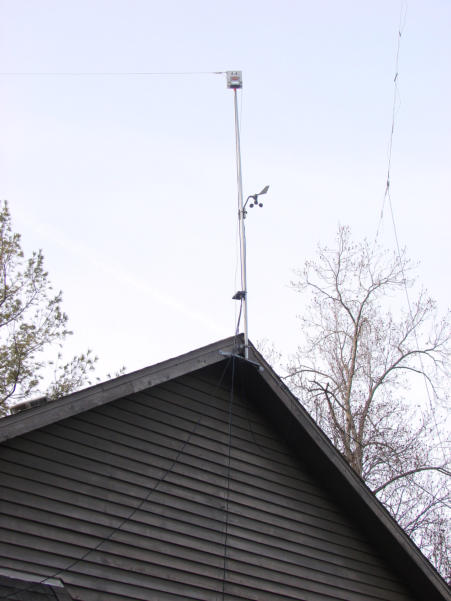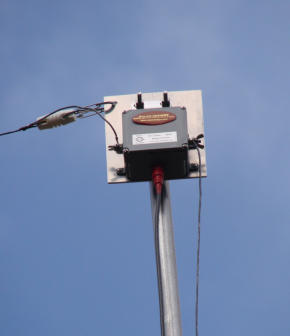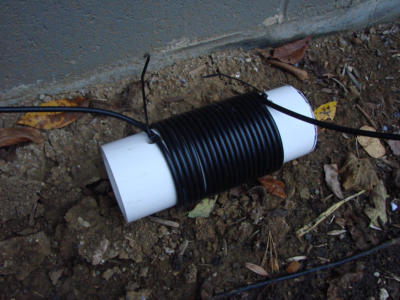My Longwire Antenna
In the fall of 2013, friends K9FN and N9FN shared some experiences they
had using a longwire antenna that incorporated a 9:1 unun made by Balun
Designs. I was looking for an antenna I could install on my 1-acre lot that would
perform better on 160M than my Butternut HF9V, and that might provide even
some modest gain at right angles relative to my “main” antenna, an Alpha Delta
DX-CC. The longwire seemed promising, with only a small time and financial
investment, and I decided to give it a shot.
I had an aluminum plate made at a local machine shop from 1/8 inch
stock. I don't remember the exact dimensions but it is probably about 6" by 8".
Cost was $15. I drilled a total of 9 holes in the plate. Four of the holes are used
to mount the unun to the plate. Another four holes are used to mount the plate
to a 10 foot long, 1-1/4" diameter TV mast using a couple of U-clamps. The
mast came from a local electronics store. The TV mast is then mounted to a
gable on my house using a Radio Shack gable mount. The peak of the gable is
about 21 feet off the ground so add 10 feet for the mast and take off 1 foot of
overlap between the gable and the mast and it would be fair to say the antenna
is about 30 feet off the ground. The ninth hole in the plate is used as an
attachment point for an S-biner. The other end of the S-biner is hooked to one
end of a plastic insulator and the other end of the plastic insulator is the tie-off
point for the longwire. A short jumper, probably about 9 inches long, connects
the left terminal on the unun to the S-biner end of the longwire. The longwire
runs from the plastic insulator to a second plastic insulator which is tied off to a
tree, also at about the 30 foot height. Total length of the wire is around 60 feet.
I feed the unun with RG-8X. A ground wire is attached to the right
terminal of the unun and runs straight down, pretty much along side the coax.
The ground wire is about 28 feet long and is not itself grounded to anything. I
simply tied it off to a nail I put in the wood siding on my house. The ground wire
is insulated, stranded #14.
I added a choke to the coax, as recommended by Balun Designs, by
winding 20 turns of the RG-8X onto some 3" PVC. The choke rests on the
ground directly under the mast. The coax leaves the choke and runs to the left
a few feet before it enters the house. See
http://www.hamuniverse.com/balun.html for info on building this choke.
The Alpha-Delta DX-CC is
at 35 feet and is oriented so that
its theoretical lobes are at 50/230 degrees. You can see it to the right of the mast in Figure 1. I didn't aim it
intentionally, that's just where the trees are. The longwire runs at a 90 degree angle to the DX-CC. I don't
know much about the radiation pattern of the longwire. I guessed that it would radiate from the longwire
section much like a dipole and would also radiate from the ground wire much like a vertical. If so, I wanted
the lobes from the longwire portion to be at a right angle to the lobes of the DX-CC in order to optimize the
patterns of the two antennae for best global coverage and to minimize interaction when I operate SO2R.
That strategy dictated what direction I chose to run the longwire and, in practice, I have found via A/B testing
that I can select between the antennas for directivity, at least on 40 meters and up. Both antennas are
probably cloud warmers on 80 and 160.
Balun Designs publishes a chart (http://www.balundesigns.com/Wire%20Lengths%20for%209-
1%20ununs.pdf) that lists multiple suggestions for the length of the longwire. I thought the 57 foot wire was
my best option based on the space I had available. The first wire I put up was probably about 60 or 62 feet
long and my plan was to trim it incrementally in order to optimize SWR. With everything in place I started
testing the SWR with my RigExpert antenna analyzer. I could see the SWR moving in the "right" direction
as I started trimming the wire but I didn't think I was ever going to get to the SWR profile that Balun Designs
lists in their chart. More importantly, the internal tuners in my radios (IC-756ProII and IC-756-ProIII) were
able to tune the thing to 1:1. So I stopped trimming. I’m not sure of the final length of the wire, maybe 59 or
60 feet. This result is similar to that experienced by K9FN and N9FN Like me, they never achieved the
SWR profile in the Balun Designs chart.
Balun Designs also suggests playing around with the ground wire, grounded vs.
ungrounded, that sort of thing. I was happy enough with the results upon first use that I
never tested any options and left it ungrounded. The ground wire comes down about 8
feet away from the entry for my house’s electrical service and its associated ground. I
may do some testing with that down the road.
I have not conducted any numerical evaluation but, in operation, I have subjectively
found the longwire to be as good or better than the Butternut HF9V that I have in the
woods behind my house. And, the 160M bandwidth is at least double the 1:1 bandwidth
I was getting with the HF9V. The longwire can also be operated on all bands including
the WARC bands. I used it as one of my two antennas for 2013 SS CW to good effect
(723 total QSO’s and a clean sweep) and have worked some DX with it including the
2013 Wake Island and Sable Island DXpeditions. In about 3 months of experience I
have not felt the need to reconnect the HF9V.




K9WX Amateur Radio











